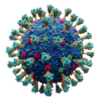Video:COVID-19 pandemic
| COVID-19 pandemic (Tutorial) | |
|---|---|
| File:En.Video-COVID-19 pandemic.webm | |
| On Commons | |
| Steps for video creation | |
| Step 1 | Preview my changes (10 sec) |
| Step 2 | Upload to Commons (10 min) |
Definition
The COVID-19 pandemic, is a global pandemic of coronavirus disease 2019 caused by severe acute respiratory syndrome coronavirus 2. The novel virus was first identified from an outbreak in the Chinese city of Wuhan in December 2019. The WHO declared a Public Health Emergency of International Concern on 30 January 2020 and a pandemic on 11 March 2020.[1][2][3]As of 30 June 2023, the pandemic had caused 767,517,959 cases and 6,947,179 confirmed deaths, making it one of the deadliest in history.[4]The WHO ended its declaration of COVID-19 being a global health emergency on 5 May 2023, but continued to refer to it as a pandemic. [5]

Epidemiology 1
SARS-CoV-2 is a newly discovered virus that is closely related to bat coronaviruses,[6]pangolin coronaviruses,[7] and SARS-CoV. [8]The first known outbreak started in Wuhan, Hubei, China, in November 2019; many early cases were linked to people who had visited the Huanan Seafood Wholesale Market there.[9][10][11]

Epidemiology 2
The earliest known infected person fell ill on 1 December 2019. That individual did not have a connection with the later wet market cluster.[12] However, an earlier case may have occurred on 17 November.[13] Molecular clock analysis suggests that the index case is likely to have been infected between mid-October and mid-November 2019.[14][15]The WHO ended its declaration of COVID-19 being a PHEIC on 5 May 2023. Prior to this, some countries had already transitioned their public health approach towards regarding COVID-19 as an endemic disease.[5]

Mitigation
Managing an infectious disease outbreak is trying to delay and decrease the epidemic peak, known as flattening the epidemic curve.[16]Non-pharmaceutical interventions that may manage the outbreak include personal preventive measures such as hand hygiene, wearing face masks, and self-quarantine; community measures aimed at physical distancing such as closing schools and cancelling mass gathering events; community engagement to encourage acceptance and participation in such interventions.[17]

References
- ↑ "Healthcare Workers". Centers for Disease Control and Prevention. 11 February 2020. Retrieved 14 February 2022.
- ↑ "Overview of the COVID-19 pandemic" (PDF). WHO. Retrieved 14 February 2022.
- ↑ "COVID-19 Public Health Emergency of International Concern (PHEIC) Global research and innovation forum". www.who.int. Retrieved 14 February 2022.
- ↑ Mathieu, Edouard; Ritchie, Hannah; Rodés-Guirao, Lucas; Appel, Cameron; Giattino, Charlie; Hasell, Joe; Macdonald, Bobbie; Dattani, Saloni; Beltekian, Diana; Ortiz-Ospina, Esteban; Roser, Max (5 March 2020). "Coronavirus Pandemic (COVID-19)". Our World in Data. Retrieved 7 July 2023.
- ↑ 5.0 5.1 Rigby, Jennifer; Satija, Bhanvi (5 May 2023). "WHO declares end to COVID global health emergency". Reuters. Archived from the original on 5 May 2023. Retrieved 6 May 2023.
- ↑ Petrosillo, N.; Viceconte, G.; Ergonul, O.; Ippolito, G.; Petersen, E. (June 2020). "COVID-19, SARS and MERS: are they closely related?". Clinical Microbiology and Infection: The Official Publication of the European Society of Clinical Microbiology and Infectious Diseases. 26 (6): 729–734. doi:10.1016/j.cmi.2020.03.026. ISSN 1469-0691. Retrieved 14 February 2022.
- ↑ Zhang T, Wu Q, Zhang Z (April 2020). "Probable Pangolin Origin of SARS-CoV-2 Associated with the COVID-19 Outbreak". Current Biology. 30 (7): 1346–1351.e2. doi:10.1016/j.cub.2020.03.022. PMC 7156161. PMID 32197085.
- ↑ "Outbreak of severe acute respiratory syndrome coronavirus 2 (SARS-CoV-2): increased transmission beyond China – fourth update" (PDF). Europe.ECDC. Retrieved 14 February 2022.
- ↑ Sun J, He WT, Wang L, Lai A, Ji X, Zhai X, et al. (May 2020). "COVID-19: Epidemiology, Evolution, and Cross-Disciplinary Perspectives". Trends in Molecular Medicine. 26 (5): 483–495. doi:10.1016/j.molmed.2020.02.008. PMC 7118693. PMID 32359479.
- ↑ "WHO Points To Wildlife Farms In Southern China As Likely Source Of Pandemic". NPR. 15 March 2021.
- ↑ Maxmen A (April 2021). "WHO report into COVID pandemic origins zeroes in on animal markets, not labs". Nature. 592 (7853): 173–174. Bibcode:2021Natur.592..173M. doi:10.1038/d41586-021-00865-8. PMID 33785930. S2CID 232429241.
- ↑ Allam, Zaheer (2020). "The First 50 days of COVID-19: A Detailed Chronological Timeline and Extensive Review of Literature Documenting the Pandemic". Surveying the Covid-19 Pandemic and its Implications: 1–7. doi:10.1016/B978-0-12-824313-8.00001-2. Retrieved 14 February 2022.
- ↑ Ma J (13 March 2020). "Coronavirus: China's first confirmed Covid-19 case traced back to November 17". South China Morning Post. Archived from the original on 13 March 2020. Retrieved 16 March 2020.
- ↑ Pekar J, Worobey M, Moshiri N, Scheffler K, Wertheim JO (April 2021). "Timing the SARS-CoV-2 index case in Hubei province". Science. 372 (6540): 412–417. Bibcode:2021Sci...372..412P. doi:10.1126/science.abf8003. PMC 8139421. PMID 33737402.
- ↑ To KK, Sridhar S, Chiu KH, Hung DL, Li X, Hung IF, et al. (December 2021). "Lessons learned 1 year after SARS-CoV-2 emergence leading to COVID-19 pandemic". Emerging Microbes & Infections. 10 (1): 507–535. doi:10.1080/22221751.2021.1898291. PMC 8006950. PMID 33666147.
- ↑ Anderson RM, Heesterbeek H, Klinkenberg D, Hollingsworth TD (March 2020). "How will country-based mitigation measures influence the course of the COVID-19 epidemic?". Lancet. 395 (10228): 931–934. doi:10.1016/S0140-6736(20)30567-5. PMC 7158572. PMID 32164834.
- ↑ "Community Mitigation Guidelines to Prevent Pandemic Influenza—United States, 2017". Recommendations and Reports. 66 (1). 2017-04-12. Archived from the original on 2020-05-03. Retrieved 2022-03-06.